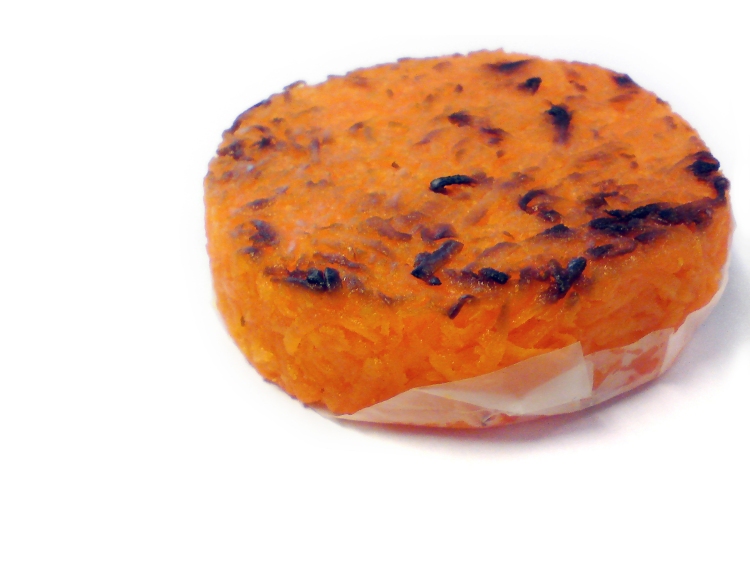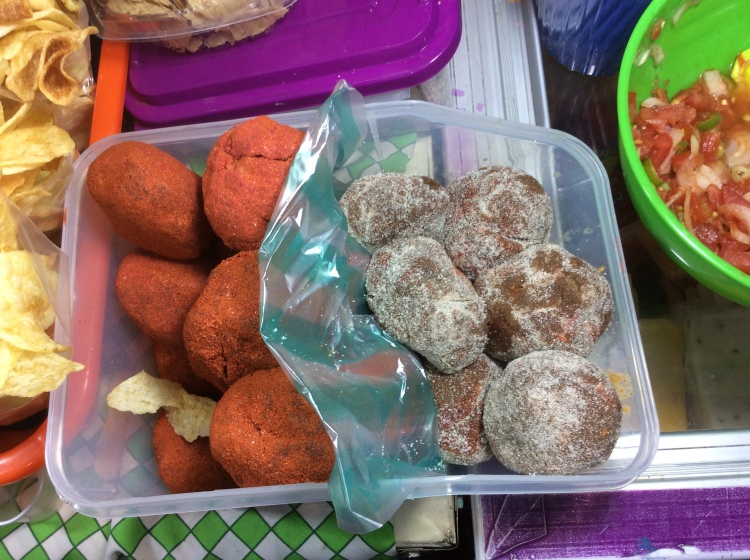Traditional Mexican sweets are not as famous as those from France, Switzerland or the US, but giving the vast variety of pastry, candy and chocolate made and consumed domestically, Mexicans have an incomparable sweet tooth. And chocolate, of course, is one of Mexico’s gifts to the world. Did you know the Aztecs were the first ones to consume the cacao bean (in drink form)?
The traditional sweets of Mexico are extra delicious because they are mostly handmade. Many of the traditional candies are made in large copper or clay pots, and the process of elaboration hasn’t changed for generations.
You can find traditional delicious sweets in every market throughout Mexico as well as in many of the festivals! Even though many commercial candies are on the shelves, traditional candy is never out of style.

The Mexican love for spicy food goes all the way to candy. At almost every corner in Mexico City one can find booths that sell different types of sweets and the selection of spicy candy is never lacking. From mango-flavored lollipops covered with chili powder to tamarind candy mixed with sugar and chiles, and even fresh fruit sprinkled with salt, lime juice and chili powder.
Next time you are in Mexico, here is a guide of some of the traditional sweets that you might find:
1. Mazapan

Mazapan is the very popular peanut version of the commonly known marzipan made of almond paste, but mazapan is more powdery and melts in your mouth.
2. Palanqueta

Another popular peanut candy, similar to peanut brittle, hard and crunchy binded with piloncillo syrup or honey; also often made with pumpkin or amaranth seeds.
3. Alegrías

Alegrías are made with amaranth seeds that are mixed with piloncillo syrup and honey. You may find them with added nuts and dried fruits or with chocolate (my favorite). These are a staple in Mexico as they’ve been prepared since the pre-Columbian era. Amaranth even served as currency at one point. Legend has it that these amaranth sweets were named alegrías (“happiness”) because that’s what you feel when you eat them.
4. Cocadas

Cocadas may be the most popular sweet, which is made with fresh shredded coconut, milk, and eggs. They are chewy, soft and delicious and come in many different forms, sizes and colors.
5. Dulce de Leche

A decadent soft candy sold in the form of bars or logs made with burnt cow’s milk. Burnt milk is also used in the well-known Mexican Cajeta, the difference is that the bars are prepared with cow’s milk while cajeta is made with goat’s milk.
6. Tamarindo con Chile

These tamarind candies are made of tamarind paste with sugar or piloncillo syrup and mixed with chili pepper powder. This candy is sweet, sour and spicy all in one. Loved by Mexicans, maybe an acquired taste for others. Tamarind candy is found in many forms and presentations like in little clay pots, big and small spoons, and in little plastic bags. You can also take your pick of just sweet tamarind, or salty tamarind, or chile tamarind. You know it’s the spicy one if it’s red in color.
6. Borrachitos

Soft, chewy and pillow shaped, these addicting sweets come in many colors and flavors including pineapple, apple, eggnog, lemon, and strawberry. But what gives this candy its name of “borrachitos” (which means “little drunk”) is that they are laced with alcohol: tequila, eggnog, coffee liquor, or wine.
They were created by nuns back in the 50s, first as a way to thank the monastery people and later realizing that they could bring a bit more money to the convent out of a small candy business by selling these candies.
7. Chicles

Chicle, or chewing gum, is a local “sweety”. The name “Chicle” comes from the nahuatl word tzictli, which is the name of the tree from which chewing gum is extracted, (another contribution from Mexico to the world). An explorer named Adams found this tree and carried its resin to the US and the Adam’s chewing gum was born.
8. Obleas

Obleas are extremely thin wafers made of wheat flour that are almost flavorless by themselves and which is why you would find them sandwiched with a delicious filling. Obleas con cajeta are very popular. As mentioned earlier, cajeta is the delicious caramelized goat’s milk. Obleas may also come in different festive colors with honey and pepitas (hulled pumpkin seeds), as seen in the photo above.
9. Ate

Ate is a thick, dense jelly made of the pulp of fruit. The most common is ate de membrillo (made with the quince fruit). One favorite of mine is the ate de guayaba, made from guava. Ate is usually sold in blocks perfect for slicing and it is good by itself but it is often paired with cheese for dessert.
10. Calaveritas de azúcar (Sugar Skulls)

Sugar skulls are seasonal, brought out in October and November for the Day of the Dead festivities, but they are one of the most unique and sweet offerings from Mexico. These sugar skulls are made from alfeñique (sugar cane paste art form), emptied into skull molds and then decorated with vibrant vegetable colors. They come in all shapes and sizes and you may find some made out of chocolate or amaranth too.
Whenever I go to Mexico I have to bring back some candy to enjoy once I get to the US. My favorites to bring are ate, cocadas, tamarind candies, and alegrías.
There are of course lots more candy out there, but this is a great first guide to traditional Mexican candy. Now tell me, which one/ones would you love to try?

So delicious!
LikeLike
Indeed delicious.
LikeLike
Mmmm. I haven’t tried any of them 😦 but they all look and sounds delicious!
We have some similar peanut brittle and the tamarind candy in India too.
Those “little drunks” sound very interesting!
LikeLike
The “little drunks” are the only ones I don’t remember trying from the list! But I had to include them because like you said, sound interesting haha. Apparently they are very popular in other states outside the big city where I lived.
LikeLiked by 1 person
I think I would like to try the alegrias and of course, the chicles as I love gum! I have never tried any of them before but now that I know what they are, I would be more inclined to try.
LikeLike
Alegrias are definitely one of my favorite.
LikeLiked by 1 person
Fun and interesting article. Thanks!
LikeLike
It was fun to write. Glad you enjoyed it.
LikeLiked by 1 person
I would love to try everything pictured, but I know to spread it out over days! I once (just once!) attended an all you can eat chocolate fundraiser with chocolate in all different forms. Suffice it to say, that I ate w-a-y too much!
LikeLike
All you can eat chocolate sounds like heaven to me!
LikeLike
Oh now I can definitely see why these would be great souvenirs! Delicious! I especially like the candy skulls!
LikeLike
Yes! They are delicious and unique. 🙂
LikeLiked by 1 person
Everything is so colourful ! It looks so tempting ! Especially the dulce the leche :p
LikeLike
Colorful is definitely a right word to describe Mexican culture. 🙂
LikeLiked by 1 person
I haven’t tried alegrías or borrachitos (my Mexican’s favourite). We go to Kensington to get all our dulces Mexicanas: tamarindo, lollipops with chile, obleas with cajeta…Glorias are one of my favourites. And I love cocadas. Haven’t seen cocadas here though. Sugar skulls would be cool to make with the kids….I’m gonna have to look into that. Awesome post!
LikeLike
You’re lucky you can get at least some of it! 🙂 I’m not sure I’ve tried Glorias.
LikeLiked by 1 person
https://images.search.yahoo.com/images/view;_ylt=AwrB8p3neW9VoAwARX8unIlQ;_ylu=X3oDMTIzaThmaXJvBHNlYwNzcgRzbGsDaW1nBG9pZAM4OGRlMjI1ZDRhMjVjNzQyMzMzZTkxODdkMWEwN2ZjZgRncG9zAzE1BGl0A2Jpbmc-?.origin=&back=https%3A%2F%2Fimages.search.yahoo.com%2Fyhs%2Fsearch%3Fp%3Dglorias%2Bcandy%2Bcajeta%26fr%3Dyhs-mozilla-001%26fr2%3Dpiv-web%26hsimp%3Dyhs-001%26hspart%3Dmozilla%26tab%3Dorganic%26ri%3D15&w=320&h=240&imgurl=4.bp.blogspot.com%2F-MWxvEkx-lME%2FTpcaw7uv9sI%2FAAAAAAAAEVM%2FFL4lBnDhiYk%2Fs320%2FIMG01605-20111012-1109.jpg&rurl=http%3A%2F%2Fyoucarewhatwethink.blogspot.com%2F2011%2F10%2Fla-sevillanas-glorias-dulce-de-leche.html&size=37.1KB&name=goodness+I%E2%80%99m+almost+at+the+end+of+this+pile+of+ass-flavored+%3Cb%3Ecandy%3C%2Fb%3E+…&p=glorias+candy+cajeta&oid=88de225d4a25c742333e9187d1a07fcf&fr2=piv-web&fr=yhs-mozilla-001&tt=goodness+I%E2%80%99m+almost+at+the+end+of+this+pile+of+ass-flavored+%3Cb%3Ecandy%3C%2Fb%3E+…&b=0&ni=21&no=15&ts=&tab=organic&sigr=12onun5hd&sigb=14f7bbnmr&sigi=132mos2l9&sigt=12epodq0t&sign=12epodq0t&.crumb=jQjpdvwdDeR&fr=yhs-mozilla-001&fr2=piv-web&hsimp=yhs-001&hspart=mozilla
LikeLike
The caption of the first photo it took me to was “goodness I’m almost at the end of this pile of ass-flavored candy” haha. They sound good though, it’s like cajeta candies.
LikeLiked by 1 person
Lol I didn’t pay attention to that, omg. I just saw the gloria sitting on top of the wrapper. It’s La Sevillana, I think, the brand. Cajeta with pecans. Soooo good.
LikeLike
Oh, las sevillanas also make the most famous obleas con cajeta. They probably use the same cajeta for the glorias.
LikeLiked by 1 person
Yes, they do. It’s the same, just with chopped pecans and gooier.
LikeLike
It all looks so delicious. I want to try it all, and I will when I visit Mexico!! I hope to do so next summer (at least that is the plan 🙂
LikeLike
I will say this – Mexico might have some of the most colorful sweets in the world. I don’t like sweets in general, but I LOVE chocolate. The dulce de leche looks awesome.
LikeLike
Chocolate is like my favorite thing in the world. The dulce de leche can be quite sweet but it’s delicious. Cajeta is kind of it’s cousin and so good too.
LikeLike